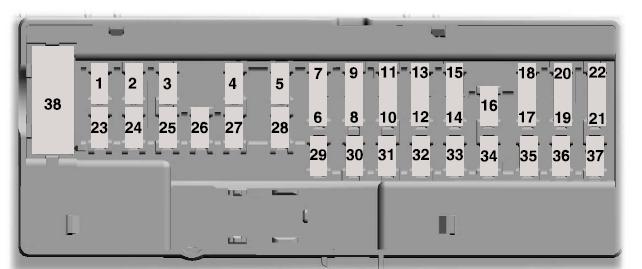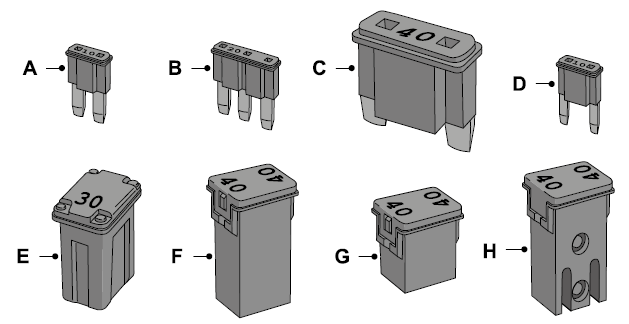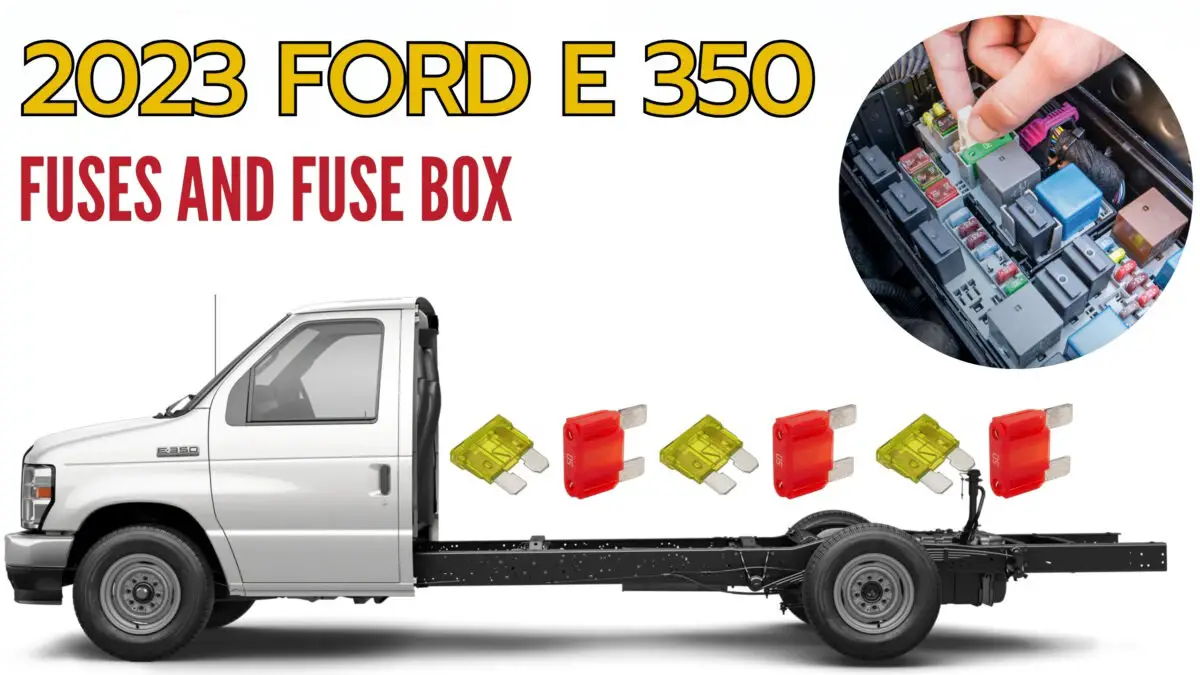2023 FORD E-350 Fuses And Maintenance User Guide
In the world of commercial vans, the 2023 Ford E-350 is a symbol of usefulness and dependability that can’t be beat. As a reliable part of Ford’s E-Series lineup, this full-size van is a great example of how flexible and useful vehicles can be. The E-350 has been trusted for a long time because it can be a reliable workhorse for businesses, a tough cargo hauler, or a large base for customization. In 2023, it still lives up to its name by combining modern conveniences with the durability that has been proven over time. Aside from its strong abilities, this vehicle is also known for its easy-to-use design, which makes sure that repair and fuse-related tasks can be done by both professionals and do-it-yourselfers. In this thorough guide, we go over the important parts of the 2023 Ford E-350’s fuses and maintenance, giving owners the information they need to keep this workhorse on the road, where it excels at getting the job done.
2023 FORD F-SERIES SUPER DUTY Specs, Price, Features and Mileage
FUSE SPECIFICATION CHART
Engine Compartment Fuse Box
WARNING: Always disconnect the battery before servicing high-current fuses.
WARNING: To reduce the risk of electrical shock, always replace the cover to the power distribution box before reconnecting the battery or refilling fluid reservoirs.
Note: If your vehicle has dual batteries, disconnecting the primary under-hood battery does not remove power from all circuits.
The engine compartment fuse box is in the engine compartment. It has high-current fuses that protect your vehicle’s main electrical systems from overloads.
If you disconnect and reconnect the battery, you need to reset some features. See Changing the 12V Battery.
Replace fuses with the same type and rating.
| Item | Rating | Protected Component |
| 1 | 20 A | Horn. |
| 2 | 50 A | Blower motor. |
| 3 | — | Not used. |
| 4 | 30 A | Starter relay. |
| 5 | — | Not used. |
| 6 | 20 A | Upfitter relay 4 (cutaway). Not used (spare) (stripped chassis). |
| 8 | — | Not used. |
| 10 | — | Not used. |
| 12 | 20 A | Powerpoint 4. |
| 13 | 10 A | Yaw sensor (stripped chassis).
Not used (spare) (cutaway). |
| 14 | 10 A | Forward-looking radar (cutaway).
Not used (spare) (stripped chassis). |
| 15 | — | Not used. |
| 16 | — | Not used. |
| 17 | 10 A | Powertrain control module run/start feed. |
| 18 | 10 A | Anti-lock brake system run/ start feed. |
| 19 | — | Not used. |
| 20 | 30 A | Wiper power. |
| 21 | — | Not used. |
| 22 | 10 A | Wiper module (stripped chassis).
Not used (spare) (cutaway). |
| 23 | — | Not used. |
| Item | Rating | Protected Component |
| 24 | 40 A | Body control module – run power in feed 2. |
| 25 | 50 A | Body control module – run power in feed 1. |
| 26 | — | Not used. |
| 27 | 20 A | Body builder frame connector. |
| 28 | — | Not used. |
| 29 | 10 A | B+ power 12 V(special order vehicle). |
| 30 | 30 A | Power driver seat (cutaway).
Not used (spare) (stripped chassis). |
| 31 | — | Not used. |
| 32 | 20 A | Vehicle power 1. |
| 33 | 20 A | Vehicle power 2. |
| 34 | 10 A | Vehicle power 3. |
| 35 | 20 A | Vehicle power 4. |
| 36 | — | Not used. |
| 37 | — | Not used. |
| 38 | 10 A | Washer relay (stripped chassis).
Not used (spare) (cutaway). |
| 39 | — | Not used. |
| 41 | 30 A | Trailer brake control connector. |
| 43 | 30 A | Instrument panel connector (stripped chassis).
Not used (spare) (cutaway). |
| 45 | — | Not used. |
| 46 | 10 A | A/C clutch. |
| Item | Rating | Protected Component |
| 47 | 40 A | Upfitter relay 1 (cutaway). Not used (spare) (stripped chassis). |
| 48 | — | Not used. |
| 49 | 30 A | Pump electronics module. |
| 50 | 15 A | Fuel injectors. |
| 51 | 20 A | Power point 1. |
| 52 | 50 A | Power at all times (PAAT) Aux AC prep on B-pillar vehicle connector (cutaway).
Not used (spare) (stripped chassis). |
| 53 | 30 A | Trailer tow park lamps. |
| 54 | 40 A | R/S feed on instrument panel connector. |
| 55 | 20 A | Upfitter 3 relay (cutaway). Not used (spare) (stripped chassis). |
| 56 | 20 A | Power point 2 prep B-pillar connector. |
| 58 | 5 A | USB smart charger. |
| 59 | 10 A | Park lamps 1 (special order vehicle). |
| 60 | — | Not used. |
| 61 | — | Not used. |
| 62 | — | Not used. |
| 63 | — | Not used. |
| 64 | — | Not used. |
| 65 | — | Not used. |
| 66 | — | Not used. |
| 67 | — | Not used. |
| Item | Rating | Protected Component |
| 69 | — | Not used. |
| 70 | 40 A | Inverter. |
| 71 | 30 A | Anti-lock brake system valves. |
| 72 | 10 A | Brake on and off switch. |
| 73 | — | Not used. |
| 74 | — | Not used. |
| 75 | — | Not used. |
| 76 | 60 A | Anti-lock brake system pump. |
| 77 | 30 A | Voltage quality module power – body control module. |
| 78 | 10 A | Trailer tow stoplamps. |
| 79 | — | Not used. |
| 80 | 10 A | Trailer tow backup lamps. |
| 81 | — | Not used. |
| 82 | 5 A | Upfitter switch (factory location for ignition power). |
| 83 | 5 A | Upfitter switch (optional location for power at all times). |
| 84 | — | Not used. |
| 85 | — | Not used. |
| 86 | — | Not used. |
| 87 | — | Not used. |
| 88 | — | Not used. |
| 89 | — | Not used. |
| 91 | 40 A | Hot at all times (HAAT) / B+PWR on B-pillar connector (cutaway). |
| Item | Rating | Protected Component |
| Battery power on instrument panel connector(stripped chassis). | ||
| 93 | 10 A | Park lamps 3 (special order vehicle). |
| 94 | 10 A | Park lamps 2 (special order vehicle). |
| 95 | 20 A | Stoplamp relay. |
| 96 | — | Not used. |
| 97 | 50 A | Battery power to Engine, B- pillar and instrument panel vehicle connectors. |
| 98 | 30 A | Trailer tow battery charge. |
| 99 | 40 A | Upfitter 2 relay (cutaway). Not used (spare) (stripped chassis). |
| 100 | — | Not used. |
| 101 | — | Not used. |
| 102 | — | Not used. |
| 103 | — | Not used. |
| 104 | — | Not used. |
| 105 | 15 A | Trailer tow right-hand and left-hand stop lamp and direction indicator relay power. |
Note: Spare fuse amperage may vary.
Passenger Compartment Fuse Box
WARNING: Always disconnect the battery before servicing high-current fuses.
Note: If your vehicle has dual batteries, disconnecting the primary under-hood battery does not remove power from all circuits.
The fuse panel is to the left-hand side of the brake pedal and mounted onto the lower left-hand cowl panel. Remove the fuse panel cover to access the fuses.
To remove a fuse, use the fuse puller tool provided on the inside of the fuse panel cover. Replace fuses with the same type and rating.
| Item | Rating | Protected Component |
| 1 | — | Not used. |
| 2 | 10 A | Left-hand front and right-hand front door lock switch (cutaway).
Inverter (cutaway). Connector (stripped chassis). |
| 3 | 7.5 A | Power mirror switch (cutaway). |
| — | Not used (stripped chassis). | |
| 4 | 20 A | Not used (spare). |
| 5 | 20 A | Not used (spare). |
| 6 | 10 A | Not used (spare). |
| 7 | 10 A | Not used (spare). |
| 8 | 5 A | Not used (spare). |
| Item | Rating | Protected Component |
| 9 | 5 A | Not used (spare). |
| 10 | — | Not used. |
| 11 | — | Not used. |
| 12 | 7.5 A | Smart datalink connector. |
| 13 | 7.5 A | Cluster.
Steering column control module. |
| 14 | 15 A | Not used (spare). |
| 15 | 15 A | Not used (spare). |
| 16 | — | Not used. |
| 17 | 7.5 A | Not used. |
| 18 | 7.5 A | R/S feed for Front blend actuator/climate mode switch (cutaway).
R/S feed to strip chassis connector (stripped chassis). |
| 19 | 5 A | Radio transceiver module and telematics control unit. Telematics control unit. |
| 20 | 5 A | Ignition switch. |
| 21 | 5 A | Not used. |
| 22 | 5 A | Bodybuilder B-pillar connector (cutaway). |
| 5 A | Not used (stripped chassis). | |
| 23 | 30 A | Not used (spare). |
| 24 | 30 A | Not used (spare). |
| 25 | 20 A | Not used (spare). |
| 26 | 30 A | Not used (spare). |
| 27 | 30 A | Not used (spare). |
| 28 | 30 A | Not used (spare). |
| Item | Rating | Protected Component |
| 29 | 15 A | Upfitter interface module (cutaway). |
| — | Not used (stripped chassis). | |
| 30 | 5 A | Not used (spare). |
| 31 | 10 A | Smart datalink connector. |
| 32 | 20 A | Radio (cutaway). |
| 33 | — | Not used. |
| 34 | 30 A | Not used (spare). |
| 35 | 5 A | Tow haul switch. |
| 36 | 15 A | Rearview mirror (cutaway). Camera lane departure (cutaway). |
| — | Not used (stripped chassis). | |
| 37 | 20 A | Not used (spare). |
| 38 | 30 A | Power window switches and motors (cutaway). |
| — | Not used (stripped chassis). |
Note: Spare fuse amperage may vary.
CHANGING A FUSE
Fuses
WARNING: Always replace a fuse with one that has the specified amperage rating. Using a fuse with a higher amperage rating can cause severe wire damage and could start a fire. 
If electrical components in the vehicle are not working, a fuse may have blown. Blown fuses are identified by a broken wire within the fuse. Check the appropriate fuses before replacing any electrical components
Fuse Types

- A Micro 2.
- B Micro 3.
- C Maxi.
- D Mini.
- E M Case.
- F J Case.
- G J Case Low Profile.
- H Slotted M Case.
Maintenance
GENERAL INFORMATION
Have your vehicle serviced regularly to help maintain its roadworthiness and resale value. There is a large network of authorized dealers that are there to help you with their professional servicing expertise. We believe that their specially trained technicians are best qualified to service your vehicle properly and expertly. They are supported by a wide range of highly specialized tools developed specifically for servicing your vehicle.
If your vehicle requires professional service, an authorized dealer can provide the necessary parts and service. Check your warranty information to find out which parts and services are covered.
Use only recommended fuels, lubricants, fluids and service parts conforming to specifications. Motorcraft® parts are designed and built to provide the best performance in your vehicle.
Precautions
- Do not work on a hot engine.
- Make sure that nothing gets caught in moving parts.
- Do not work on a vehicle with the engine running in an enclosed space, unless you are sure you have enough ventilation.
- Keep all open flames and other burning material (such as cigarettes) away from the battery and all fuel-related parts.
Working with the Engine Off
- Set the parking brake and shift the transmission to park (P).
- Switch off the engine.
- Block the wheels.
Working with the Engine On
WARNING: To reduce the risk of vehicle damage and personal burn injuries, do not start your engine with the air cleaner removed and do not remove it while the engine is running.
- Set the parking brake and shift the transmission to park (P).
- Block the wheels.
OPENING AND CLOSING THE HOOD
- Inside the vehicle, pull the hood release handle located under the bottom left corner of the instrument panel.
- Go to the front of the vehicle and push the auxiliary latch, located in the center of the top grille, to the left in order to release the hood.
- Lift the hood and secure it with the prop rod.
- To close, lower the hood and make sure that it is closed properly and fully latched.
UNDER HOOD OVERVIEW

- A Windshield washer flauid reservoir. See Washer Fluid Check
- B Automatic transmission fluid dipstick. See Automatic Transmission Fluid Check
- C Engine oil dipstick. See Engine Oil Dipstick
- D Air cleaner assembly. See Changing the Engine Air Filter
- E Engine oil filler cap. See Engine Oil Check
- F Brake fluid reservoir. See Brake Fluid Check
- G Engine coolant reservoir. See Engine Coolant Check
- H Engine compartment fuse box. See Fuses
- I Power steering fluid reservoir. See Power Steering Fluid Check
- J Battery. See Changing the 12V Battery
ENGINE OIL DIPSTICK

- A Minimum.
- B Nominal.
- C Maximum.
ENGINE OIL CHECK
- Make sure that your vehicle is on level ground.
- Check the oil level before starting the engine, or switch the engine off after warm-up and wait 10 minutes for the oil to drain into the oil pan.
- Remove the dipstick and wipe it with a clean, lint-free cloth.
- Reinstall the dipstick and make sure it is fully seated.
- Remove the dipstick again to check the oil level.
Note: If the oil level is between the maximum and minimum marks, the oil level is acceptable. Do not add oil. - If the oil level is at the minimum mark, immediately add oil.
- Reinstall the dipstick. Make sure it is fully seated.
Note: The oil consumption of new engines reaches its normal level after approximately 3,000 mi (5,000 km).
Adding Engine Oil
WARNING: Do not add engine oil when the engine is hot. Failure to follow this instruction could result in personal injury.
WARNING: Do not remove the filler cap when the engine is running.
Do not use supplemental engine oil additives because they are unnecessary and could lead to engine damage that the vehicle warranty may not cover.
- Clean the area surrounding the engine oil filler cap before you remove it.
- Remove the engine oil filler cap.
- Add engine oil that meets our specifications.
- Reinstall the engine oil filler cap. Turn it clockwise until you feel a strong resistance.
Note: Do not add oil further than the maximum mark. Oil levels above the maximum mark may cause engine damage.
Note: Immediately soak up any oil spillage with an absorbent cloth.
Engine Oil Pressure Warning Lamp
WARNING: If it illuminates when you are driving do not continue your journey, even if the oil level is correct. Have your vehicle checked.
![]() It illuminates when you switch the ignition on.
It illuminates when you switch the ignition on.
If it illuminates when the engine is running this indicates a malfunction. Stop your vehicle as soon as it is safe to do so and switch the engine off. Check the engine oil level. If the oil level is sufficient, this indicates a system malfunction. Have your vehicle checked as soon as possible?
OIL CHANGE INDICATOR RESET
Base Cluster
Use the information display controls on the steering wheel to reset the oil change indicator.
FAQ
The 2023 Ford E-350 uses blade-style fuses.
The fuse box is typically located in the interior of the vehicle, often under the dashboard or in the engine compartment. Refer to your owner’s manual for the exact location.
A blown fuse can usually be identified by a broken wire inside the fuse or a visibly burnt appearance. However, it’s advisable to use a multimeter or a fuse tester for accurate diagnosis.
Replace the blown fuse with one of the same amperage rating to restore the circuit’s functionality. You can typically find spare fuses in the fuse box or obtain them from an auto parts store.
The amperage rating for replacement fuses should match the rating specified in your vehicle’s owner’s manual or onthe fuse box cover.
Common electrical issues that can lead to blown fuses include short circuits, overloaded circuits, and faulty electrical components.
Fuses typically don’t need frequent replacement unless there’s a specific electrical issue. Regularly checking your vehicle’s electrical systems for problems can help prevent blown fuses.
Refer to your owner’s manual for the manufacturer’s recommended maintenance schedule, which typically includes oil changes, tire rotations, brake inspections, and other routine tasks.
The oil change interval for the E-350 may vary depending on factors like driving conditions and oil type, but a common recommendation is every 5,000 to 7,500 miles or as specified in the owner’s manual.
The recommended engine oil type and viscosity can be found in your owner’s manual. It’s important to use the specified oil to ensure proper engine performance.
The air filter should be inspected regularly and replaced when it’s dirty or clogged. This typically occurs every 15,000 to 30,000 miles.
Tire pressure should be checked monthly and before long trips. Refer to the recommended tire pressure values in your owner’s manual or on the driver’s side door jamb.
Brake pads and rotors should be inspected regularly for wear and replaced as needed. The frequency of replacement depends on driving habits and conditions.
Ensure the battery terminals are clean and free of corrosion. Regularly check the battery’s voltage and replace it if it shows signs of weakening.
Yes, following the recommended maintenance schedule is important for the longevity and performance of your vehicle. Regular maintenance can help catch and address potential issues before they become major problems.
Useful Link
FORD E-350 2023 User Guide
FORD E-350 2023 Auxiliary Power Points User Guide
2023 FORD F-SERIES SUPER DUTY Specs, Price, Features and Mileage


